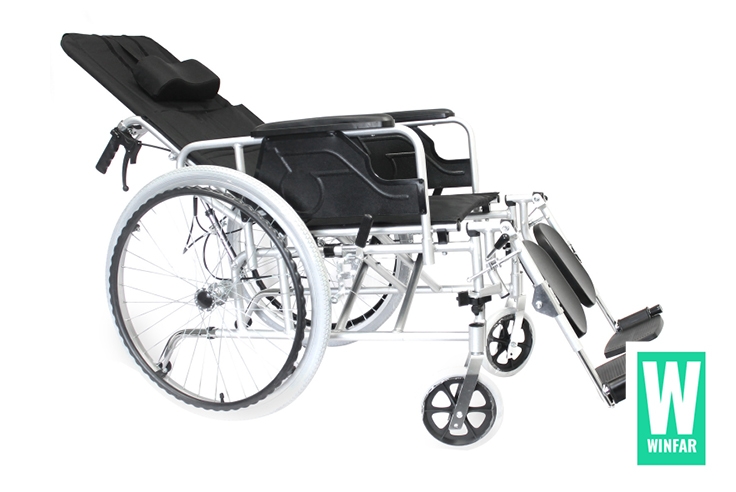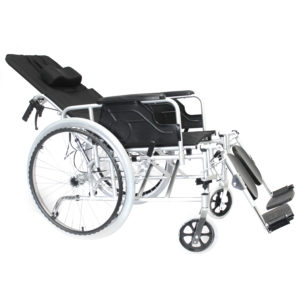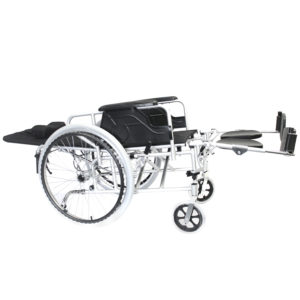Most people won’t encounter the problem of bedsores or pressure sores. However, wheelchair users, people who are bedridden, or those with physical or mobility impediments, do! Primarily because they spend extended periods of time in the same position. This constant pressure can cause the skin to become red, inflamed, and deprives the skin cells of oxygen.
For many wheelchair users, this problem is overcome by repositioning, that is the constant intentional shifting of their body position. Repositioning is important for both the comfort and health of a wheelchair user as it increases blood oxygenation, and reduces the risk of pressure ulcers. It should happen a minimum of once every 2 hours. But it presupposes that the user has sufficient upper body strength to lift their full body weight and shift.
This is however not always the case.
And this is where reclining wheelchairs come into play.
What is a recliner wheelchair?
Like a reclining easy chair, the seatback of an adjustable wheelchair tilts back. This reclining feature allows a person to change their body position and relieve the tension of the high-pressure zones, whilst still in the chair, without having to get up. Although the degree of the angle can vary from wheelchair to wheelchair, most allow a person to recline up to 180 degrees – completely flat.
While simultaneously allowing you to lift and straighten the legs with the feet up, enabling the person to lie completely flat in the chair.
Pros and Cons of reclining wheelchairs
As with everything, there are advantages and disadvantages.
One of the biggest pros in favour of the reclining wheelchair is that it allows a person to change position without getting out of the chair. Adjusting the user’s posture and center of gravity to relieve the constant pressure felt on certain parts of the body. This ability to change the bodies position, without physical exertion, relieves and redistributes the pressure, increasing circulation, and preventing the likelihood of skin damage.
The ability to change position quickly in a reclining chair also makes it an ideal option for caregivers. It is much easier to change a diaper or catheter on a person in a reclined position, compared to when he or she is sitting upright. Plus, many people find it easier to help a person out of a reclining wheelchair into a bed, or chair, than to help a person out of a conventional chair.
But these advantages come with a price!
Aside from the chair’s ability to recline, one of the biggest differences between a reclining wheelchair and a standard wheelchair is the mobility of the chair.
Reclining wheelchairs aren’t for everyone. Although you can transport the chair or move a person around in one, they are not recommended for people who enjoy a fair degree of independent mobility, who are looking for a chair to serve as a means of transportation and compliment a fairly active lifestyle.
Conventional wheelchairs are self-propelled, meaning a person can move about in the chair without assistance. The same is not true of a reclining chair. The purpose of a reclining wheelchair is to increase comfort when seated for extended periods of time. It is not designed for movement.
For the most part, a person in a reclining wheelchair will need to have someone else push the chair from one location to another. Most models can’t be self-propelled.
Remember, no one product will be right for everyone.
In making your decision always consider the needs of the person (and their strength), the environment in which they live, and the activities they engage in.
A person with limited upper body strength, who struggles with self-repositioning, and unable to use manual alternatives, will gain the most benefit from a reclining wheelchair.
PRODUCT FOCUS: WINFAR RECLINING WHEELCHAIR 16” AND 18″
Special features: full recliner wheelchair with extended back/headrest. Removable side guard armrests & detachable elevating footrests.
Frame Type: Fold up aluminium frame
Arm & Footrests: Flip-up full length armrests. Detachable elevating footrests that can adjust to different angle
Seat Width: Available in 2 sizes: 16” (40cm) and 18″ (45cm) seat width
Front & Rear Wheels: 8” Solid front castors and pneumatic 24″ rear wheels
Brakes: Unity brakes.
Weight Capacity: 100kg
Nett Weight: 18 kg’s
Sources:
https://www.passionatepeople
https://www.caring-for-aging-parents.com/reclining-wheelchair.html
https://www.karmamedical.com/2020/08/the-benefits-of-a-reclining-and-tilting-wheelchair/
https://www.movementadvisor.com/reclining-wheelchair/
https://www.invacare.com.au/sites/default/files/The%20Clinical%20Benefits%20of%20Recline_ANZ.pdf
https://mobilitymgmt.com/articles/2014/11/01/tilt-recline.aspx
https://www.passionatepeople.invacare.eu.com/can-a-reclining-wheelchair-assist-with-postural-management



